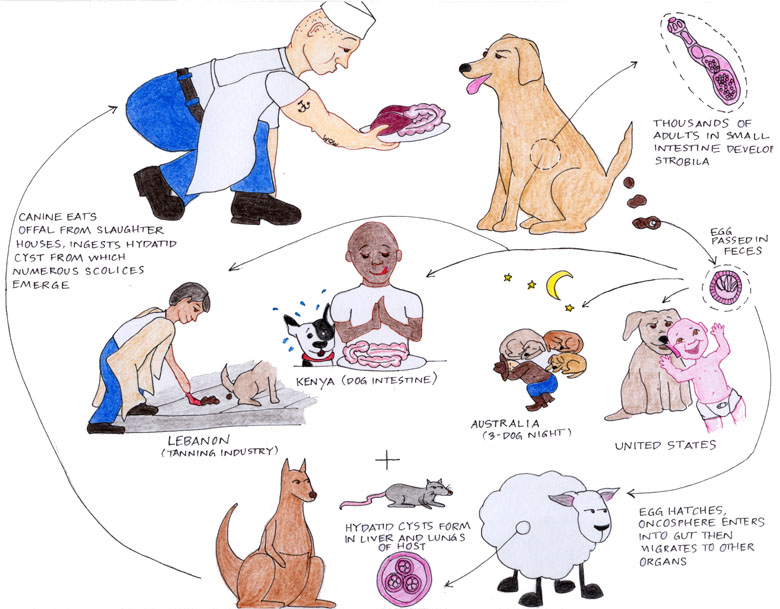

Echinococcus granulosus is a tapeworm of dogs and other canines. The worms are diminutive, 3-6 mm in length and composed of a scolex and a single immature, mature and gravid ploglottid. Echinococcus employs a strategy different from most other taeniids, in that larger taeniids produce more eggs per proglottid but are represented by a lesser worm burden. Echinococcus worm burdens on the other hand are enormous. Egg capsules are passed in the canine stool contaminating herbage that herbivores may eat. In the intermediate host, the eggs develop into endogenous hydatid cysts which contain hundreds to thousands of protoscolices. When a hydatid cyst is eaten, each of the protosolices develops into a diminutive adult. Sheep are common intermediate hosts but goats, camels, pigs, kangaroos, and reindeer are also intermediates in their respective environs. Rodents are common intermediate hosts of a closely-related species, Echinococcus multilocularis. Humans inadvertently become involved in the life cycles when they ingest egg capsules from the stool of canines...mostly dogs. The result is the development of a hydatid cyst in humans. The cysts often grow to sizes, larger than those realized in other intermediate hosts. Many times, the cysts are in the brain, lungs, bones or liver where they crowd out surrounding tissue. There are tribes within Kenya where dog intestine is considered a delicacy. The intestine is cleaned by merely forcing out the feces after which the intestine is scorched on a stick, leaving numerous eggs in the intestine still alive. The Turkana of Kenya leave their dead on burial cairns to be eaten by scavengers. In this instance, humans actually represent true intermediate hosts if the bodies are eaten by canine scavengers. Sheepherders may be infected by too close an association with their sheep dogs. In Lebanon, the tanning industry uses dog feces to help color the leather. Those apprentices assigned to collecting dog stools from the street risk infection. Some tribes in Africa train their dogs to lick vomitus off of young children's faces, thereby contaminating them with eggs that may be clinging to the dog's muzzle as a result of the dog licking it's anus after defecating.